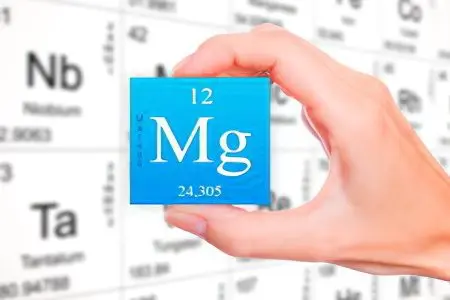Contents
However, not all doctors today prescribe such drugs to their patients who are diagnosed with hypertension or another disease of the cardiovascular system. Often it’s just out of ignorance.
Magnesium, meanwhile, helps reduce blood pressure and keep it normal, thus improving well-being.
Under what pathologies can magnesium be indicated?

Magnesium deficiency leads to:
From the side of the cardiovascular system: arrhythmia, microcirculation disorders, headaches, angina pectoris and tachycardia, a tendency to thrombosis and, of course, high blood pressure.
Headaches, unmotivated fear, depressive states, dizziness, absent-mindedness and difficulty concentrating, memory problems and confusion.
Magnesium deficiency is also observed in diseases of the gastrointestinal tract. It can be associated with nausea and vomiting, it can cause constipation and diarrhea, diffuse abdominal pain, stomach and intestinal cramps. Spasms of the sphincter of Oddi and increased uterine tone, as well as bronchospasm and eclampsia, can also be manifestations of magnesium deficiency.
Magnesium can cause ailments on the part of the muscular system in the form of cramps in the back of the head, cramps in the facial and dorsal muscles, calf muscles, the effect of tetany (“obstetrician’s hands”), deafness and paresthesia of the extremities.
With sufficient intake of magnesium into the human body, it eliminates vascular spasms, relieves nervous tension. That is why intravenous injections of magnesia, in other words, magnesium sulfate, are prescribed during hypertensive crises. The effect becomes noticeable very quickly. However, magnesium is not always used in long-term therapy.
At the same time, the action of magnesium is similar to that of a series of drugs that block calcium channels. In fact, it is a natural calcium antagonist, but devoid of the side effects of synthetic drugs.
Magnesium ions (Mg2+) are able to quickly bring blood pressure back to normal and normalize heart rhythm, prevent increased thrombosis, slow down the formation of cholesterol plaques, and do not allow calcium (“lime”) to accumulate on the walls of blood vessels.
The role of electrolytes in the body

Together with calcium, as well as potassium and sodium, magnesium is part of the group of electrolytes. Their task is to maintain electrolyte balance. For this, it is necessary that the proportions of these substances in the cells are in a certain ratio.
With magnesium deficiency, there is an excess of calcium and sodium. A blood test for electrolytes helps determine this. Comparison of the analyzes of sixty people who had just suffered an acute myocardial infarction and one hundred healthy people showed that sodium and calcium predominate in the first group in the blood. In the second group, the balance of all three electrolytes was observed.
All this means that you should not impose strict restrictions on salt in the diet. The smarter way is to take magnesium. This will help restore the correct electrolyte ratio. However, overeating salt is also not recommended.
Magnesium also works to prevent anemia by regulating hemoglobin levels and eliminating iron deficiency. If the proportion of magnesium in plasma is fixed at a level of 0.80 mmol per liter or less, the risk iron deficiency anemia is doubled. An indicator less than 1,50 mmol / l increases it five times.
The following symptoms indicate a lack of magnesium:
increase in blood pressure,
arrhythmia,
muscle cramps and spasms,
constant fatigue
insomnia,
increased nervousness,
frequent constipation,
difficult premenstrual period in women (PMS).
Magnesium and cardiovascular risk
Magnesium deficiency leads to diseases such as hypertension, arrhythmia and coronary artery disease, myocardial infarction, heart failure, provokes excessive blood clots, increasing blood viscosity.
Taking supplements with magnesium can eliminate most of these problems. It helps to get rid of arrhythmias, as well as heart failure, reduce pressure and dilute the blood.
The introduction of magnesium in post-infarction therapy raises the survival rate of patients. This is indeed a good assistant for cardiologists.
Vegetovascular dystonia and other diseases

Low blood pressure can also develop as a result of magnesium deficiency. In this case, the diagnosis of “vegetovascular dystonia” is possible.
Comparison of blood test data of 100 people with this pathology and 30 healthy people showed magnesium deficiency in the first group. In them, the content of this element in plasma was determined at the level of 0.74±0,28 mmol/l (norm – 0,7-1,2), in urine – 67,73±8,24 mmol/l (73-122).
When a certain substance is deficient, the body drastically reduces its excretion in the urine to maintain balance. People suffering from vegetative-vascular dystonia in this study showed constant disruptions in electrolyte balance.
Lack of magnesium leads to a decrease in pressure and a decrease in muscle strength. And the more magnesium is contained in the daily urine, the greater the risk of developing arterial hypertension. If you raise the concentration, the risk will decrease.
Despite the fact that the official norm of magnesium in plasma corresponds to 0,7-1,2 mmol / l, treatment is already required at parameters of 0,8 mmol / l. This will help reduce the high risk of developing heart and vascular diseases by 2-5 times. For a more accurate diagnosis, it is better to examine the blood for magnesium content in red blood cells.
A value of less than 0,80 mmol / l increases the risk that convulsions, tachycardia, mitral valve prolapse, unstable angina and arterial hypertension may develop.
Magnesium deficiency also leads to excess weight, contributes to the development of type XNUMX diabetes mellitus and its accompanying complications. Accordingly, in the presence of these diseases, a person runs the risk of dying prematurely.
How to take magnesium for hypertension?
Magnesium helps reduce blood pressure by 3-15 millimeters of mercury. When the content of this substance in the body comes to a normal level, a person can quickly eliminate anxiety and insomnia. In combination with vitamin B6 in the treatment of hypertension, magnesium acts even more effectively!
Magnesium preparations, sold in pharmacies, allow you to get enough of this mineral, reducing blood pressure. A “side effect” of such therapy is the elimination of other signs of magnesium deficiency.
According to experts, magnesium preparations may well become a full-fledged component of hypertension therapy without the use of medications. This will help reduce the pressure and then keep it at a normal level by taking vitamins, amino acids and minerals.
But here there may be a problem with the dosages of drugs that are indicated on the products of different manufacturers. This may be a dose of pure magnesium or a dose of magnesium salts.
Patients suffering from renal insufficiency should study this information very carefully. And be wary of all means intended to lower blood pressure. Taking magnesium is only under the supervision of a doctor, possibly in a hospital setting.
Pregnancy hypertension: prevention and treatment

During pregnancy, a lack of magnesium can provoke hypertension, as well as other manifestations of a difficult pregnancy. It is known that when a pregnant woman develops high blood pressure, as a rule, there is a lack of magnesium and potassium, while sodium is present in the blood in a comparative excess.
This does not mean that you should completely stop using salt, since taking magnesium supplements helps restore electrolyte balance. And you don’t have to stick to a salt-free diet. An advertisement for one of the magnesium preparations, which includes vitamin B6, is accompanied by the words: “You will love being pregnant.”
Observations of women during the first pregnancy, who were prescribed three hundred grams of magnesium per day after the twenty-fifth week, showed that by the thirty-seventh week their blood pressure was lower than in the group not taking the drug – by five millimeters of mercury. Another study, in which one hundred and fifty pregnant women were observed, showed a decrease in the frequency of manifestations of hypertension, an easier course of pregnancy and childbirth.
Which foods contain magnesium?
Record-breaking products for magnesium content (per 100 g of product) are:
Sea urchins (including caviar) – 1016 mg
Rice bran – 781 mg
Wheat bran – 611 mg
Sesame (white and black) – 640 mg
Pumpkin seeds – 535 mg
Watermelon seeds – 515 mg
Flax seeds – 392 mg
Brazil Nuts – 376mg per (beware of selenium poisoning!)
Cashews – 292 mg
Almonds – 268 mg
Pine nuts – 251 mg
Peanuts – 176 mg
Hazelnuts – 163 mg
Walnut – 158 mg
Pistachios and pecans — 121 mg
Sunflower seeds – 157-317 mg
Cocoa powder – 25 mg per 1 teaspoon!
Halibut – 107 mg
Banana (1 pc.) – 80 mg
Conclusions
A fact that is well known to physicians: the introduction of magnesium sulfate (magnesia) into a vein helps to quickly reduce blood pressure levels. This property is widely used by emergency doctors.
At the same time, the tablet form of magnesium intake is not so common. Doctors do not always suggest that patients use magnesium supplements with vitamin B6 in the treatment of hypertension. Of course, before taking magnesium, it is necessary to check the condition of the blood and urine.
Magnesium supplementation has been shown to increase the effectiveness of conventional hypertension medications and even help manage side effects. For example, with heart rhythm disturbances and atherosclerosis, which may develop. By taking magnesium tablets, the patient can avoid excessive excretion of magnesium in the urine. And also reduce the level of potassium in the blood, which can increase ACE inhibitors. It has been observed that taking magnesium along with other medications reduces their negative side effects.









